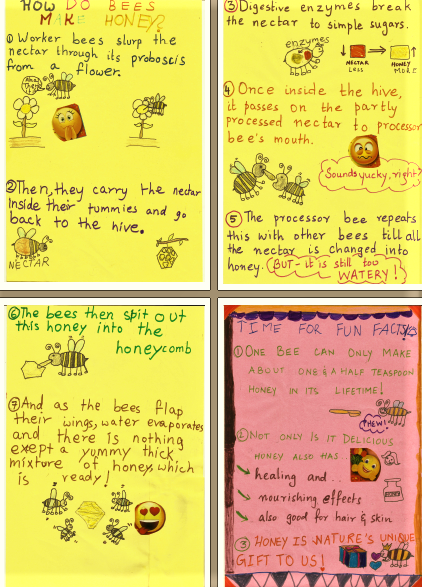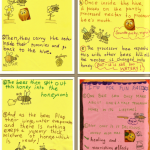
Honeybee Lifecycle: Creative Learning for Kids
Have you ever wondered how those busy bees transform flower nectar into the golden sweetness we call honey? A young artist, Amina, has captured this amazing process in a delightful infographic. Join us as we explore Amina’s artistic creation and delve into the intriguing honeybee lifecycle!
Honeybees, those tireless workers of the natural world, are essential for pollinating the flowers that bring us fruits, vegetables, and even the cotton in our clothes. Understanding how these little creatures create honey is a wonderful way for children to learn about science and the interconnectedness of nature.
A Bee’s Journey – From Flower to Hive
Amina’s artwork beautifully depicts the different stages of a honeybee’s life:
-
Egg: It all begins with the queen bee, the heart of the hive, who lays tiny eggs in the honeycomb cells. These eggs, no bigger than a grain of rice, hold the promise of new life.
-
Larva: Soon, the eggs hatch into larvae, little white grubs that are constantly hungry. Worker bees, the nurses of the hive, diligently feed them a special food called royal jelly.
-
Pupa: As the larvae grow, they spin cocoons around themselves and enter the pupa stage. Inside these cocoons, a miraculous transformation takes place, as the larvae develop into adult bees.
-
Adult Bee: After about three weeks, the adult bee emerges from its cocoon, ready to take on its role in the hive. Worker bees are the busiest, collecting nectar and pollen, building the honeycomb, and caring for the young. Drones, the male bees, have only one job: to mate with the queen. And the queen, of course, is responsible for laying eggs and ensuring the survival of the colony.
Honey-Making Magic – Step by Step
Amina’s infographic cleverly illustrates how bees make honey:
-
Step 1: Worker bees, like little explorers, venture out into the world in search of nectar-rich flowers. They use their long, straw-like tongues called proboscis to suck up the sweet nectar.
-
Step 2: The bees carry the nectar back to the hive in their honey stomachs, where it mixes with special enzymes that start breaking it down into simple sugars.
-
Step 3: Back in the hive, the bees regurgitate the nectar into honeycomb cells. They then fan their wings tirelessly to evaporate excess water, turning the nectar into the thick, golden liquid we know as honey.
-
Step 4: Once the honey reaches the perfect consistency, the bees cap the honeycomb cells with beeswax, preserving the precious treasure for future use.
The Buzz About Honey
Amina’s artwork also shares some fun facts about honey:
- Did you know that there are many different types of honey, each with its own unique flavor and color?
- A single bee can only make about one-twelfth of a teaspoon of honey in its lifetime!
- Honey is not just delicious; it also has healing and nourishing properties, making it a true gift from nature.
Get Creative!
Inspired by Amina’s beautiful work, why not try creating your own honeybee infographic or artwork? You can use paper, markers, crayons, or even natural materials like leaves and twigs to bring your ideas to life. Remember, there are no right or wrong answers in art; just let your creativity flow!
Conclusion
We hope you enjoyed learning about the honeybee lifecycle and the magical process of honey-making through Amina’s creative lens. As we marvel at the intricate dance of nature, let us also remember to appreciate the vital role that honeybees play as pollinators. They are truly the unsung heroes of our ecosystem!
Share Your Creative Artwork with Curious Times!
We invite all young artists to share their honeybee-inspired creations with us.
You can submit your artwork at https://curioustimes.in/subscriber-posts/. We can’t wait to see your masterpieces!
Watch a video
Buzz into the bee-utiful world of honeybees with Pants Bear!
Curious Times is a leading newspaper and website for kids. We publish daily global news aligned to your learning levels (also as per NEP 2020): Foundational, Preparatory (Primary), Middle and Senior. So, check out the News tab for this. We bring kids’ favourite Curious Times Weekly newspaper every weekend with top news, feature stories and kids’ contributions.
ME – My Expressions at Curious Times is your place to get your work published, building your quality digital footprint. And it is a good way to share your talent and skills with your friends, family, school, teachers and the world. Thus, as you will step into higher educational institutes your published content will showcase your strength.
Communicate with us: Instagram.
0 (Please login to give a Curious Clap to your friend.)
SignUp to Participate Now! Win Certifiates and Prizes.


Login/Signup